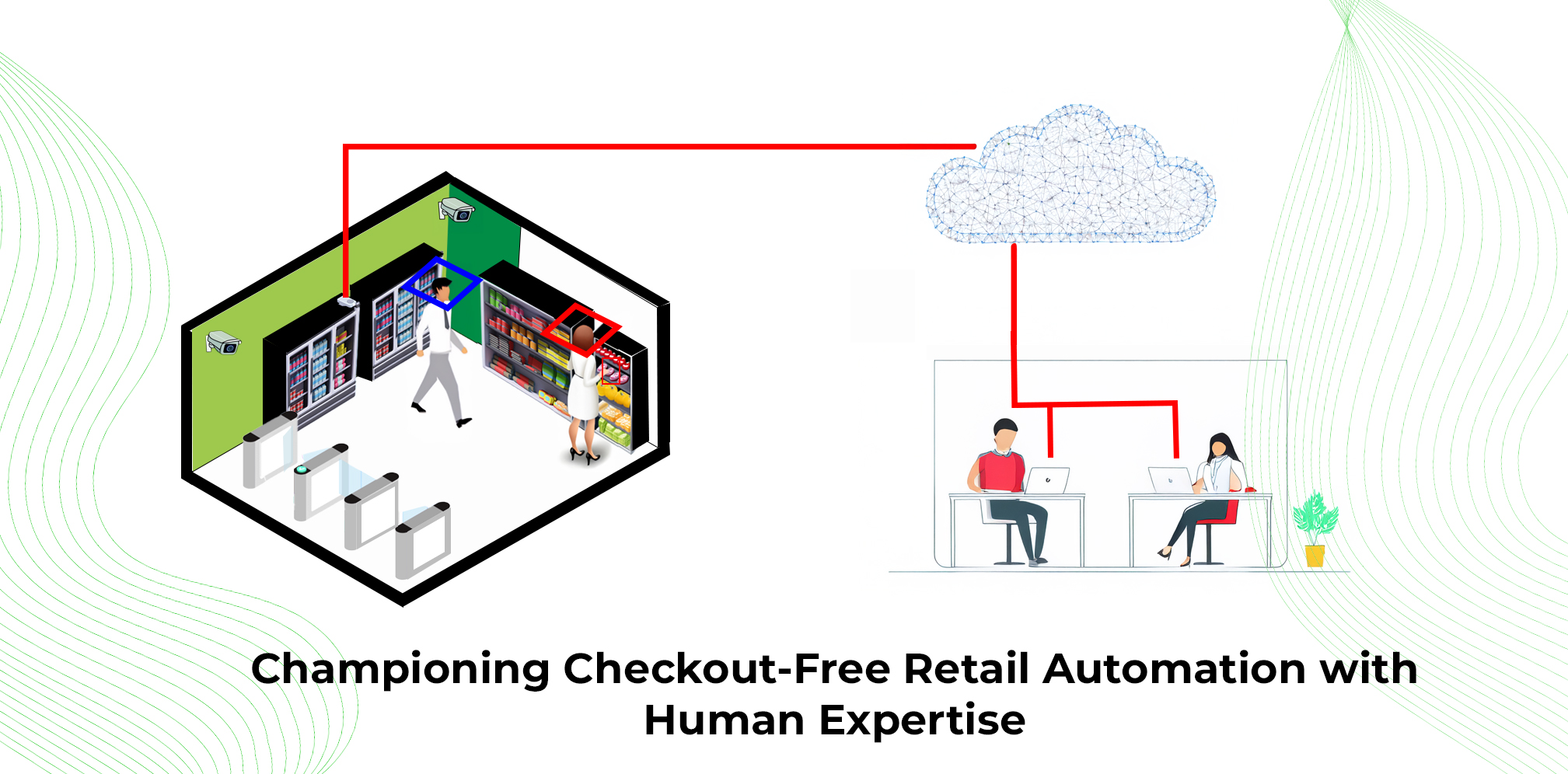“Hassle-free” and “frictionless” have become the gold standards for modern, tech-driven shopping experiences. Beyond self-checkouts, emerging technologies enable businesses to merge security, greater convenience, and transactional speed at the customer’s last touchpoint.
As consumer expectations for a high-quality shopping experience evolve across physical and digital retail, checkout-free shopping delivers higher customer satisfaction. For businesses, Autonomous retail technology promises improved sales through valuable real-time inventory and consumer behavior data to optimize stock levels and operations.
Yet, adding human perspective and intervention in the AI loop ensures technological accuracy, adaptation to complex scenarios, and a seamless experience.
This blog explores how integrating cutting-edge technology with expert human-in-the-loop can deliver true wins for retailers by addressing checkout-free AI challenges and boosting bottom-line benefits.
A Closer Look at Checkout Challenges
According to a recent study, 48% of online shoppers in the US have abandoned their carts during checkout in the past three months. Of this, 22% of shoppers abandoned an order only because of a long or complicated checkout process.
The research exposed other checkout challenges shown below:

Focusing on offline shoppers, the habitual abandonment of long checkout lines negatively impacts brick-and-mortar store sales, as highlighted by the following statistics.

Going Checkout-Free – An Omnichannel Opportunity
Checkout-less transactions at omnichannel retail touchpoints offer the following benefits:
- Labor Optimization: POS employees can focus on customer service and high-value assistance rather than just transactional interactions.
- Loss Prevention: Human-led AI, computer vision, and sensors significantly reduce theft and inventory inaccuracies that undermine business performance.
- Customer Analytics: Product and pricing preference data fetched from a customer’s shopping history can help devise personalized promotions and virtual carts.
- Reduced Abandonment: Adding efficiency, convenience, and brand perception encourages repeat visits while eliminating checkout bottlenecks.
- Brand Differentiation: Checkout-free solutions offer competency and appeal to consumers seeking seamless, tech-driven experiences.
From Concept to Reality: Walk Out to Checkout
Grubhub has leveraged Amazon’s Walk Out technology to make shopping frictionless at university campuses. Students can scan a QR code in the Grubhub app to enter a convenience store, where the technology detects all the products they take or return from the shelves. They can leave without waiting in line, with payment automatically processed through their meal plan or linked Grubhub account.
Though smart checkouts deliver last-mile shopping convenience, the increased adoption of this technology poses the following challenges and pain points that retailers must tackle for seamless integration and customer acceptance:
- System Integration: Successfully integrating checkout technologies with existing retail systems requires deep domain expertise and seamless compatibility to ensure smooth operation.
- Accuracy and Tracking: Checkout-free systems require computer vision to track items, but errors in object detection, like misidentifying products or missing actions, lead to incorrect billing and inventory issues while frustrating customers and undermining system reliability.
- Technology Maintenance and Downtime: Advanced AI automation may encounter checkout system downtime and disruptions that only human intervention in the loop can resolve.
- Customer Adoption: More tech awareness and user-friendly interfaces are needed to ensure a smooth, smart checkout transition.
- Fraud Prevention: Injecting robust and AI-driven security features for checkout systems ensures resistance to fraud and misuse of system data.
- Handling Edge Cases: Checkout-less shopping faces challenges with:
- Identifying unpackaged or loosely arranged items.
- Managing returns or exchanges in-store.
- Adapting to cultural or human nuances, such as group shopping or child-parent interactions.
The Truth is in the Numbers
In today’s unpredictable macroeconomic landscape, a Zippin consumer study found that 79% of retailers plan to tackle checkout challenges by adopting self-checkout or checkout-free solutions, aiming to regain customer trust after friction-filled in-store experiences.
Industry analysts predict the growth in the number of stores using checkout-less shopping from 250 globally in 2021 to over 12,000 by December 2027. Customers have also shown keen interest, with 70% in a UK survey indicating they would likely use this automation experience.
The global self-checkout systems market is projected to grow at a CAGR of 16.2% from 2022 to 2030, reaching $13.98 billion by 2030 and $47 billion by 2032, according to Fortune Business Insights. This growth is driven by factors such as increased urbanization, and the advancements of in-store automation, and payment solutions, highlighting the sector’s strong potential.
Optimize Customer Journeys, Not Just Touchpoints
Checkout-free technology allows stores to deliver personalized shopping experiences. To maximize its impact, retailers must leverage Human-in-the-Loop (HITL) integration, where human experts fine-tune systems for accuracy, handle complex scenarios, detect fraud, and provide real-time intervention. Experts also help train and validate AI models, improving personalization and efficiency.
Research indicates that 25% of customers will defect after one bad experience. Customer-experience leaders can improve by digitizing key customer journeys using multidisciplinary teams to rapidly design, test, and iterate processes based on customer feedback. Human involvement enables fast, scalable process improvements within 20 weeks.
Statistical Landscape of HITL in Checkout-Less Retail Automation
Human-in-the-loop (HITL) integration has gained momentum across industries, underscoring checkout-less shopping with the following advantages.
- Accuracy Improvement: Incorporating HITL can boost AI accuracy by 20-30% in complex tasks like multi-object tracking, customer behavior analysis, and interactions.
- Error Reduction: According to McKinsey reports, retail systems using HITL for billing and inventory checks see up to a 40% reduction in errors.
- Customer Trust: A 2024 Deloitte survey revealed that 68% of customers are more comfortable with AI systems when human oversight is present, highlighting HITL’s role in building trust.
- Time to Resolution: HITL processes resolve billing discrepancies in under 2 minutes on average, compared to over 8 minutes in fully automated systems.
- Market Growth: The global HITL market, valued at $2.5 billion in 2023, is projected to grow at a 15% CAGR, driven by increasing adoption in retail, healthcare, and autonomous systems.
Augmenting the AI Pipeline Through HITL Deployments
AI models in retail automation operate predominantly in supervised learning modes where human expertise is crucial for the following tasks:
- Labeling and Annotation: Depending on the complexity, a domain expert or a trained employee labels the training dataset.
- Re-engineering the Model: ML engineers or programmers may optimize the algorithm using the provided dataset to optimize its performance.
- Training and Retraining: Employees feed the model with annotated data, assess its output, make corrections, add more data, and retrain the model.
- Monitoring Post-Deployment Performance: The human-in-the-loop process continues after deployment. ML engineers selectively verify outputs by monitoring the model’s performance with the client’s consent. These cases are then used to enhance the initial training dataset, improving the model’s performance.

Demystifying the Technology
Checkout-free retail solutions combine sensors, computer vision, AI, and HITL to lay inroads to seamless customer experiences. The typical components are demonstrated below:
Human Perspective in Retail Automation Enriches Smart Checkout
By tackling challenges and delivering competent user experience, checkout-free stores represent the future of retail, particularly when market dynamics are rife. HITL-based AI embeds reliability and insights in the autonomous process, making it the silver lining in retail innovation.
NextWealth: Forging a Checkout-Free Future
As online and offline retailers continue to upgrade their automation strategies, HITL-based deployments are essential for fine-tuning pre-trained models and optimizing outcomes in supervised and semi-supervised learning. NextWealth offers unique and optimal HITL solutions that include:
- Superior Key-Point Annotations: Ensures AI models and humans integrate to accurately interpret customer actions and navigate complex scenarios.
- Human Expert Integration: Embeds experts into the annotation pipeline to eliminate ambiguity and improve accuracy through continuous feedback.
- Scalability Across Retail Formats: Achieves economies of scale across diverse store environments.
- Faster Customization and Rollout: Accelerates the deployment of competitive and customized checkout-less solutions.
Unlock the future of HITL-powered retail automation, delivering unmatched customer experiences. Connect with us to explore leading strategies for a seamless transition. Get your free demo today!

